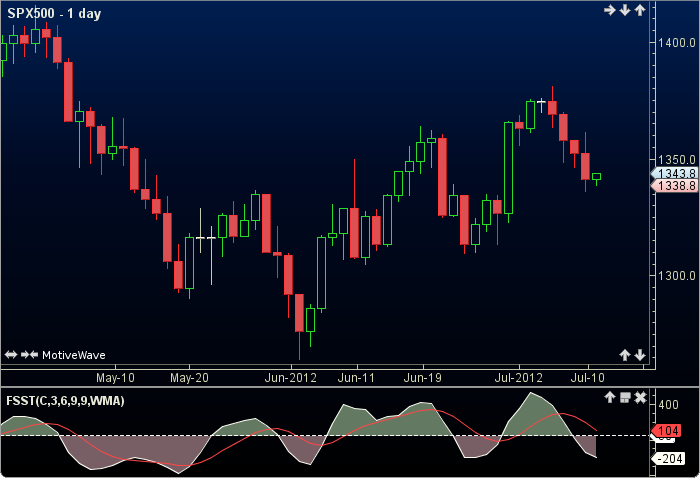Fast And Slow Stochastics
Fast And Slow Stochastics (FSST) was authored by U. Jenson for Omega Research, 1997. First, the FSST calculates the Fast and Slow Kurtosis (FSK) using Momentum, previous Momentum and previous FSK (feedback) along with a percentage factor. Next, the FSST uses the FSK and Stochastics for the final calculation. A signal line, which is a weighted moving average of itself, is also given. This indicator’s definition is further expressed in the condensed code given in the calculation below.
See also Fast And Slow Kurtosis

How To Trade Using Fast And Slow ST
Although a signal line is plotted, no signals are currently calculated for this indicator.
How To Access in MotiveWave
Go to the top menu, choose Study>Oscillators>Fast&Slow ST
or go to the top menu, choose Add Study, start typing in this study name until you see it appear in the list, click on the study name, click OK.
Important Disclaimer: The information provided on this page is strictly for informational purposes and is not to be construed as advice or solicitation to buy or sell any security. Please see our Risk Disclosure and Performance Disclaimer Statement.
Calculation
//input = price, user defined, default is closing price
//method = moving average (ma), user defined, default is WMA
//period1 = user defined, default is 3
//period2 = user defined, default is 6
//period3 = user defined, default is 9
//period4 = user defined, default is 9
//prev = previous, stochK = Stochastis fast K
//index = current bar number
mom = momentum(index, period, input); prevMom = mon[index-1]; prevFsk = FSK[index-1]; fsk = (.03 * (mom - prevMom)) + ((1 - .03) * prevFsk); v4 = ma(method, index, period2, fsk); fastk = stochK(index, period3, key); slowk = ma(method, index, period3, fastK); fsst = 500 * v4 + slowk; wfsst = ma(method, index, period4, fsst);
